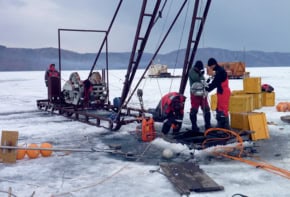
Neutrino detectors contain up to tens of thousands of tonnes of liquid scintillator that emits a flash of light whenever it interacts with a neutrino. Such scintillators are typically organic compounds dissolved in organic solvents, so are toxic and highly flammable. By contrast, the water-based quantum dot liquid scintillator developed by a team headed up at King’s College London (KCL) in the UK, is non-toxic and non-flammable – making it less hazardous to work with, as well as more environmentally friendly.
Quantum dots (QDs) are tiny semiconductor crystals that confine electrons and behave like artificial atoms when absorbing and emitting light. The new scintillator contains commercially available 6.4 nm-diameter QDs – optimized to emit the blue light wavelengths preferentially detected by particle physics photon sensors – which the researchers dissolved in the organic solvent toluene before mixing with water and a stabilizing agent of oleic acid molecules.
This mixture was then “agitated to create an emulsion, similar to shaking a bottle of salad dressing to mix oil and vinegar,” explains Aliaksandra Rakovich, who co-led the research along with Teppei Katori. Finally, after settling, the water and oil phases separated and the water phase – now containing the QDs – was further diluted with water to reach the correct concentration for detecting particles such as neutrinos.
As detailed in their recent Journal of Instrumentation paper, the researchers measured the light emitted from a small sample of their liquid scintillator while cosmic rays (atmospheric muons) passed through it. This revealed a high scintillation yield, comparable to that from existing scintillators. The absorbance and emission spectra also remained stable over two years: an essential quality for neutrino experiments, which typically take several years to acquire data.
“The potential for our new scintillator is huge because quantum dots can have so many different types of core and different sizes, so you can choose all kinds of absorption and emission spectra,” says Katori, whose current work includes helping to design the Japan-based international Hyper-Kamiokande neutrino experiment due to start operating in 2027.
Katori hopes that within 5–10 years the new scintillator could not only replace those used in large-scale detectors for dark matter, neutrons or neutrinos, but could also form the basis for desktop-sized generic radiation sensors. It could also help monitor the neutrino spectrum close to the reactor core in nuclear power facilities: this spectrum alters if plutonium is being illegally extracted.
Next, the researchers aim to “develop methods for large-scale synthesis of QDs directly in water”, says Rakovich, adding that this will include removing cadmium and other toxic elements to “reduce the ecological footprint even further”. They also intend to carry out quantitative testing and optimization of stability, safety and performance in increasingly larger samples of their scintillator while under neutrino bombardment over long time scales.
Alex Himmel, a scientist at Fermilab in the USA, who was not involved in the research study, says that he finds this new scintillator promising. “For some time there has been substantial interest in making water-based liquid scintillators which have advantages in terms of safety and cost,” explains Himmel, who is co-spokesperson for Fermilab’s NOvA neutrino experiment, which currently uses an organic liquid scintillator.

New technique makes directional measurements of low-energy solar neutrinos
“Safety is always a top concern when building particle physics experiments, both for the obvious reason that we don’t want anyone to get hurt, and because potentially dangerous materials typically require costly safety measures,” says Himmel. “If the materials themselves are less hazardous, it makes the experiments easier and cheaper to build and operate.”
Himmel says that the KCL researchers “estimate 4000 photons per MeV from their test sample”, noting that “our experiment operates today at similar light yields”. But he cautions that for this new liquid scintillator to be adopted by end-users it must “be produced cost-effectively at large scales and show a light yield that is stable over time”.



